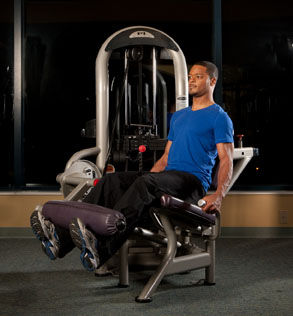
By Jim Gerard
A new study suggests that you don’t have to hoist heavy weights to get bigger and stronger. Is this a revolutionary discovery that will force us to completely rethink strength training? Or are these claims based on seriously flawed research, as detractors suggest? Here’s how our experts weighed in on the topic…
From time immemorial—or at least since the 1950s—the mantra for people looking to boost muscular size and strength has been to lift heavy weights (usually defined as those that can be lifted only from three to 10 times with proper form).
However, a study published in the Journal of Applied Physiology says that half-century of research is, well, heavy-handed (Mitchell et al., 2012).
Researchers at McMaster University in Canada recruited 18 healthy men to participate in the study, all of whom were in their early 20s and recreationally active, but who hadn’t lifted weights before. Over a period of 10 weeks, subjects were assigned a combination of three different programs that required them to complete as many repetitions as possible on the leg extension machine, depending upon their assigned programs—eight to 12 reps for the heaviest weights and 25 to 30 reps for the lightest. The three programs used in the combinations were:
- One set at 80 percent of the maximum load
- Three sets at 80 percent of the maximum load
- Three sets at 30 percent of the maximum load
The researchers concluded that doing more repetitions using lighter weights is just as effective at muscle-building as the heavy-weight protocol—as long as the subjects trained to momentary muscular failure (a.k.a. fatigue, or the inability to finish your last rep in a set with proper form).
Stuart Phillips, Ph.D., one of the researchers and a professor in McMaster’s department of kinesiology, explains that these findings are consistent with the size principle, in which the body, when needed to perform a task, recruits all its motor units (nerves that activate muscle fibers), from the smallest to the largest.
The smallest motor units activate slow-twitch fibers, and the largest units activate fast-twitch fibers—the ones that generate greater force. “People in the strength-conditioning world have said, correctly, that if you lift a heavier weight, you activate both the small and large motor units. But the size principle says that if the smaller motor units (slow-twitch fibers) get fatigued, the muscle dips into the fast-twitch fibers.”
In short, Phillips says, your muscles react the same way upon reaching fatigue, regardless of whether you’re at your fifth rep (presumably at a heavy weight) or your twenty-fifth.
“Since most resistance-training programs are designed to make you stronger,” argues Phillips, “all you need to do to make all your muscle fibers grow is to load and work to fatigue.” In short: The amount of weight you lift doesn’t matter.
Karen Croteau, Ph.D., an associate professor of exercise science at the University of Southern Maine, believes the science of the McMaster study valid, which isn’t surprising given that she describes herself as “a lifelong proponent of the idea that you [don’t] need to lift very heavy weights for many sets to get the same benefits as the heavy lifters.”
Croteau likes the idea that an individual can do “one set of all the major muscle groups in a half hour and get similar gains in muscle size and strength—assuming that these results carry over to other major muscle groups.” Croteau’s caveat stems from her concern that the McMaster study looked at only the quadriceps, and mainly at just one of its four muscles.
And therein lies the source of many arguments against the validity of the study, of which we found many. Not to mention the fact that, as many critics pointed out, the study contradicts a broad body of past research.
Other Experts Don’t Buy It
William Kraemer, Ph.D., is director of research at the Human Performance Laboratory at the University of Connecticut and one of the country’s leading experts on strength training. He says that the major problem with the McMaster study is that “it goes against solid research acquired since the 1950s showing that to build optimal strength you have to lift heavy loads.” (Croteau also admitted as much.)
“Besides which,” Kraemer continues, “it violated a ton of physiological rules and contradicts what we know—that you can’t strengthen bone and connective tissue without training heavily.”
Finally, Kraemer echoes Croteau’s reservation—that the study’s volunteers were asked to do only knee extensions and not a total-body weight-training program.
Jeffrey Potteiger, Ph.D., dean of graduate students in the department of movement science at Grand Valley State University in Grand Rapids, Mich., agrees with Kraemer’s assessment of the study. “Scientific literature shows that gains in strength are a result of training volume—the number of sets times the number of reps times the resistance used,” explains Potteiger. “The McMaster paper even proves this. While all the subjects got stronger, the ones who did three sets got stronger than the ones who did one set.”

Potteiger also cites as flaws both the study’s short duration and the inexperience of its subjects in weight training. He says that there are two components to strength training: muscular and neurological (the coordination necessary to, say, perform a free-weight bench press). “If you put untrained people on a strength-training program and gave them time to practice, they’d eventually improve their balance in three planes of movement,” which would make it easier for them to lift heavier weights, explains Potteiger. Phillips’s subjects used a leg extension machine, which is easier to control. The logical conclusion is that the McMaster results might have been very different had they used veteran weight trainers as their subjects.
Phillips disagrees. “The strength gains occurred in the early part of the study, and if the study had been longer, we’d have continued to see increases. You’d have to do a 24- or 48-week study to disprove our study.”
Other critics cited as a weakness the small number of study volunteers, all from a very specific cohort—men in their early 20s, with, as Croteau put it, “high levels of testosterone” that might’ve caused them to build muscle faster than other groups.
Phillips’ response: “We’re all the same species; we all gain strength in fundamentally the same way. I’ve never seen evidence that there’s something fundamentally different about the way older people or women gain strength.”
In fact, Phillips says the researchers’ primary motivation for undertaking the study was to establish that the elderly or other people with joint problems could achieve results “that established people in the field say can’t happen.”
So What Should Fitness Pros Tell Their Clients?
One unequivocal result of the McMaster study is that it has reignited the debate between the heavy-weight/low-rep and the light-weight/high-rep strength-training camps, a dispute that continues to rage in gyms everywhere.
In light of the study, how should trainers adjust their training practices (if at all)? What should they tell their clients, some of whom might be inclined to subscribe to the McMaster results and alter their training accordingly?
Not necessarily, says Stan Reents, Pharm.D., president and CEO of AthleteInMe.com (R), a Phoenix-based company that provides exercise advice and guidance to consumers. “The lower-weight, higher-reps protocol might be a good strategy for the older population—over 60—or anybody of any age who hasn’t exercised in many years, is extremely deconditioned or has joint problems or other health issues such as high blood pressure.”
Potteiger thinks strength training—light, heavy and in-between—is a matter of individual preference. However, for the average person who just wants to maintain his or her strength level, he suggests doing “a total-body workout, two to three days a week consisting of two to three sets for each body part using a weight that can lifted comfortably.”
Kraemer, on the other hand, considers the McMaster regimen “really a recovery workout” to be followed on one’s light training days, if at all.
So what can fitness pros take away from this study? According to Reents, the main point is to recognize that “the traditional ways of training are still valid, but they’re more similar than previously thought.”
And that is exactly Phillips’ point. “You still have to get to the gym, but once you get to the gym, the sets, reps and other factors—the 15 or 20 variations that trainers think are important—aren’t that important. Whether you’re training light or heavy, your muscles don’t know difference.”
That assertion, presuming it contains an element of truth, begs the question: Can people combine light with heavy weight training? The answer seems to be: It depends—on whom you ask and the individuals’ goals.
Croteau doesn’t advise a constant switching of light/heavy protocols for the average person, but admits that it could work for, say, runners seeking to increase upper-body strength or “competitive athletes, whose whole-body regimen might change from in-season to off-season.”
Pottieger, however, sides with the bulk of research. “The literature is pretty clear—to get bigger and stronger, you don’t do a lot of high-rep training.” He also points out that the argument often excludes crucial factors such as genetics and age.
Clearly, while the issue remains settled for some experts, others still see questions in need of answers. Phillips told ACE Certified News that his team has been working on another study that he claims will solidify the credibility of their earlier work. His contention is fighting a half-century of contrary evidence.
Perhaps someday everyone will be lifting lighter loads. However, for now, the jury is still out.
References
Mitchell, C. J. et al. (2012). Resistance exercise load does not determine training-mediated hypertrophic gains in young men. Journal of Applied Physiology, 113, 1, 71–77.
_____________________________________________________________________

Jim Gerard is an author, journalist, playwright and stand-up comic. He has written for the New Republic, Travel & Leisure, Maxim, Cosmopolitan, Washington Post, Salon, Details, New York Observer, and many other magazines. For more information, visit his site at www.gangof60.com.